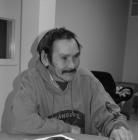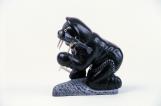1
Simeonie Elijassiapik2009
Inukjuak Co-operative, Inukjuak, Quebec, Canada
 Credits:
Credits:Photo: Devora Cascante
2
Simeonie Elijassiapik [b. 1948]"To see my work improve has made me feel very good, and it is even more encouraging for me when Qalluanaaq and fellow Inuit want to buy my work." (1994)
"I now receive letters from all over the world from Qalluanaaqs, some of whom I've never met, requesting carvings and telling me how much they enjoy the work I do. When I am carving, it is not like working. It is more of an enjoyment and the money I get is more of a perk." (1994)
"I mostly carve soapstone, but I carve antler and ivory too. The soapstone is my favourite. There are different types of stone, some soft and some hard, and when I'm finished what I wanted to do, I'm very satisfied with my work." (2009)
His story
Simeonie Elijassiapik was born February 1948 in a small hunting camp north of Inukjuak. He first took up carving in 1962, but only became serious about it in 1964, at the age of 16. "When I was first beginning to carve, I witnessed other people getting things that I could not afford. For example, someone bought a gun and I envied that person very much. I used to have a teenage friend who was slightly older than me and he used to carve and get things he wanted… It was the envy of things that got me started as a carver," he said during an interview with the Inuit Art Foundation's Simeonie Kunnuk in 1994. Hunting was the main theme of his first carvings. His father, also named Elijassiapik, and well-known Inukjuak carver, Johnny Inukpuk, had taught him to hunt and might have had some influence on Elijassiapik's artistic development as well. In a 1997 IAQ article, Matthew Fox wrote: "Conscious of his reputation as a well-established carver, he has encouraged young people in Inukjuak to pursue art as an occupation" (p. 14). Elijassiapik also worked as a purchase manager for the co-op.
His art
Elijassiapik's themes have evolved to include shamanic transformations. He has successfully combined his father's traditional approach and Johnny Inukpuk's stylistic conventions. Fox wrote: "Elijassiapik's carvings often incorporate Inukpuk's oversized, exaggerated hands, and stylized treatment of the parka trim. His carvings continue the tradition of emphasizing the mouth and teeth but, instead of ivory inlay, he simulates the same effect by scratching on the eyes and by giving the figure protruding teeth as if they had been carved out of ivory" (ibid). He also uses pop cans to measure his carvings, which, on average, measure three to four cans high. He says that if he is making a carving that he knows will be shipped south, he purposely makes it more bulky so that it will not break. For carvings that he sells within the community, he is able to add more detail.
His achievements
Elijassiapik's talents have been highly praised by his fellow artists, recognition that makes him proud. In 1981, he was awarded first prize in a sculpture competition organized by members of the Inukjuak co-op. His bold and individual style has proven to be commercially successful in Europe and North America. His work has been featured twice in solo exhibitions: at the Marion Scott Gallery (Vancouver) and The Guild Shop (Toronto). Elijassiapik is represented in the permanent collections of at least three Canadian institutions: the Canadian Museum of Civilization (Gatineau, Québec), Musée de la civilisation (Québec City), and the Ministère des affaires culturelles du Québec (Québec City).
References
Fox, Matthew
1997 "Focus On: Simeonie Elijassiapik," Inuit Art Quarterly (IAQ), vol. 12, no. 4 (winter).
3
Simeonie Elijassiapik29 January 2009
Inukjuak Co-operative, Inukjuak, Quebec, Canada
 Credits:
Credits:Translation: Annie Weetaluktuk

